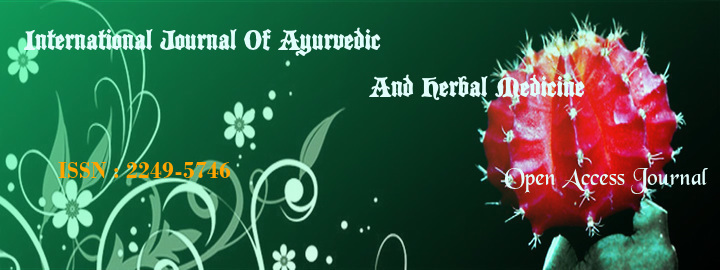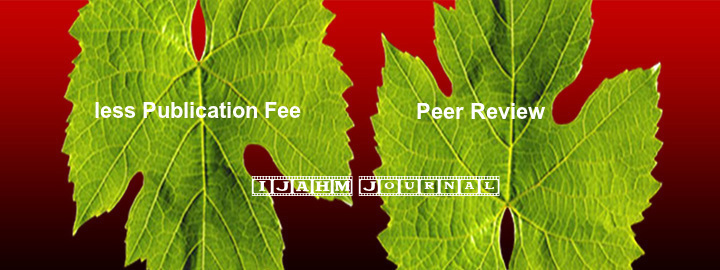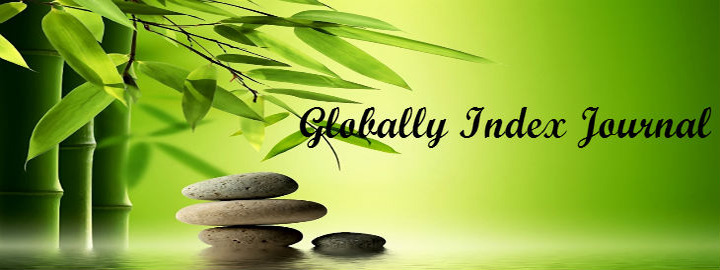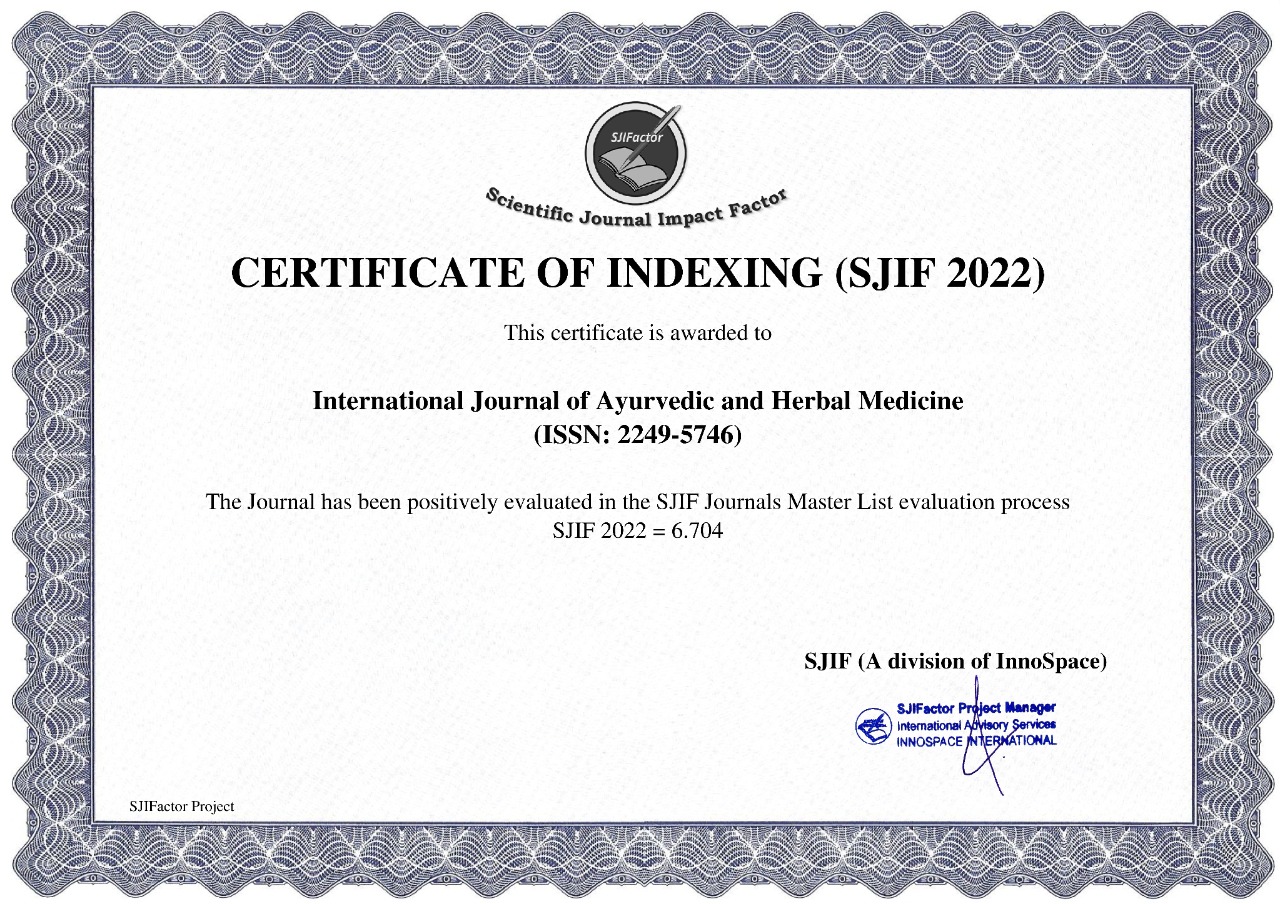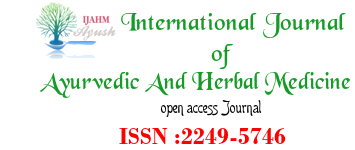


1Dr Swapna Tandale, 2Dr Sanjivani S. Shekokar
DOI : http://dx.doi.org/10.47191/ijahm/v12i2.07
1Post Graduate Student, Department of Dravyaguna, Government Ayurved College, Nanded.
2Associate Professor and Head of Department, Department of Dravyaguna, Government Ayurved College, Nanded.
ABSTRACT:
Ayurvedic literature shows that plants of Anacardiaceae family are having many important medicinal uses as well as commercial uses. The present study is aimed to study the characteristics and uses of some important plants belonging the Anacardiaceae family. A literature review of few important plants of the family is being carried out in this study with the help of literature from Ayurvedic texts and with help of various related web portal and articles. Most of the plants from Anacardiaceae family are flowering plants, having resin which causes irritation present in bark of stem, pericarp of fruit or leaf.
Key words: - Anacardiaceae, anti-inflammatory, anti-pyretic, anti-cancer, antimicrobial
REFERENCE :
- http://www.britannica.com/topic/list-of-plants-in-the-family-Anacardiaceae-2039149
- Bapalal g. Vaidya. Nighantu Adarsh Vol 1 st, Varanasi: Chaukhamba Publication: 2017 page no. 314
- R. Kirtikar, B.D. Basu Indian Medicinal Plants vol 1st , 2nd edition, Lalit Mohan Basu, page no.
- K.R. Kirtikar, B.D. Basu Indian Medicinal Plants vol 1st , 2nd edition, Lalit Mohan Basu, page no. 652
- R. Kirtikar, B.D. Basu Indian Medicinal Plants vol 1st , 2nd edition, Lalit Mohan Basu, page no. 666
- P.V. Sharma. Dravyagunvigyan Vol 2nd Varansi , Chaukhamba Bharati Publication: 2017 page no.166
- K.R. Kirtikar, B.D. Basu Indian Medicinal Plants vol 1st , 2nd edition, Lalit Mohan Basu, page no. 659
- K.R. Kirtikar, B.D. Basu Indian Medicinal Plants vol 1st , 2nd edition, Lalit Mohan Basu, page no. 672
- K.R. Kirtikar, B.D. Basu Indian Medicinal Plants vol 1st , 2nd edition, Lalit Mohan Basu, page no. 657
- Muanza DN, Euler KL, Williams L, Newman DJ. Screening for antitumor and anti-HIV activities of nine medicinal plants from Zaire. International Journal of Pharmacology. 1995; 33:98.
- Krushnachandra Chunekar Bhavprakash Nighantu Varanasi Chaukhamba Publication2018 Page no.540
- WadoodN, Abmad N, Wadood A. Effect of Mangifera indica on blood glucose and total lipid levels of normal and alloxan diabetic rabbits. Pakistan Journal of Medical Research 2000; 39(4):142-145.
- Beltrana AE, Alvareza Y, Xaviera FE, Hernanza R, Rodriguezb J, Nunezb AJ et al. Vascular effects of the Mangifera indica L. extract (Vimang). European Journal of Pharmacology 2004; 499:297-305.
- Nithitanakool S, Pithayanukul P, Bavovada R. Antioxidant and hepatoprotective activities of Thai mango seed kernel extract. Planta Medicine 2009; 75:1118-1123.
- Awe SO, Olajide OA, Oladiran OO, Makinde JM. Antiplasmodial and antipyretic screening of Mangifera indica extract. Phytotherapy Research 1998; 12:437-438.
- Sairam K, Hemalatha S, Kumar A, Srinivasan T, Ganesh J, Shankar M et al. Evaluation of anti-diarrheal activity in seed extracts of Mangifera indica. Journal of Ethnopharmacology 2003; 84:11-15.
- Alkizim FO, Matheka D, Abdulrahman FK, Muriithi A. Inhibitory effect of Mangifera indica on gastrointestinal motility. Medicinal Chemistry and Drug Discovery 2012; 2(1):9-16.
- Chattopadhyay U, Guha S, Ghosal S. Antitumor, immunomodulatory and anti-HIV effect of mangiferin, a naturally occurring glucosylxanthone. Chemotherapy 1996; 42:443-451.
- Zhu XM, Song JX, Huang ZZ, Whu YM, Yu MJ. Antiviral activity of mangiferin against herpes simplex virus type 2 in vitro. Zhongguo Yao Li Xue Bao 1993; 14:452-454.
- Zheng MS, Lu ZY. Antiviral effect of mangiferin and isomangiferin on Heppex simplex virus. Chinese Medical Journal. 1990; 103:160-165.
- Guha S, Ghosal S, Chattopadyay U. Antitumor, immunomodulatory and anti-HIV effect of mangiferin: A naturally occurring glucosylxanthone. Chemotherapy 1996; 42:443-451.
- Tona L, Kambu K, Ngimbi N. Antiamoebic and spasmolytic activities of extracts from some antidiarrheal traditional preparations used in Congo. Phytomedicina 2000; 7:31-38.
- Devi CS, Sabitha KE, Jainu M, Prabhu S. Cardio protective effect of mangiferin on isoproterenol induced myocardial infarction in rats. Indian Journal of Experimental Biology. 2006; 44:209-215.
- Morais TC, Lopes SC, Karine-Carvalho MMB, Arruda BR, Souza FTC, Trevisan MTS et al. Mangiferin a natural xanthone, accelerates gastrointestinal transit in mice involving cholinergic mechanism. World Journal of Gastroenterology. 2012; 18(25):3207-3214.
- Krushnachandra Chunekar Bhavprakash Nighantu Varanasi Chaukhamba Publication2018 Page no. 134
- (http://tropical.theferns.info>viewtr...Semicarpous anacardium – Useful Tropical Plants )
- Sharma A, Mathur R, Dixit VP. Hypocholesterolemic activity of nut shell extract of Semecarpus anacardium (Bhilawa) in cholesterol fed rabbits. Indian J Exp Biol 1995;33:444-8.
- Ramprasath VR, Shanthi P, Sachdanandam P. Immunomodulatory and anti-inflammatory effects of Semecarpus anacardium LINN. Nut milk extract in experimental infl ammatory conditions. Biol Pharm Bull 2006;29:693-700
- Verma N, Vinayak M. Bioscience Reports Immediate Publication; 2008. p. BSR20080035
- 30 Sahoo AK, Narayanana N, Sahanaa S, Rajanb SS, Mukherjee PK. In vitro antioxidant potential of Semecarpus Anacardium L. Pharmacologyonline 2008;3:327-35.
- 31 Farooq SM, Alla TR, Rao NV, Prasad K, Shalam K, Satyanarayana S. A study on CNS effect of nut milk extract of Semicarpus anacardium. Pharmacologyonline 2007;1:49-63.
- Mohanta TK, Patra JK, Rath SK, Pal DK, Thatoi HN. Evaluation of antimicrobial activity and phytochemical screening of oils and nuts of Semecarpus anacardium. Sci Res Essay 2007;2:486-90.
- Nair A, Bhide SV. Antimicrobial properties of different parts of Semecarpus anacardium. Indian Drugs 1996;33:323-8.
- Arul B, Kothai R, Christina AJ. Hypoglycemic and antihyperglycemic effect of Semecarpus anacardium Linn in normal and streptozotocin-induced diabetic rats. Methods Find Exp Clin Pharmacol 2004;26:759-62.
- Arulkumaran S, Ramprasath VR, Shanthi P, Sachdanandam P. Alteration of DMBA-induced oxidative stress by additive action of a modifi ed indigenous preparation--Kalpaamruthaa. Chem Biol Interact 2007;167:99-106.
- Sharma A, Verma PK, Dixit VP. Effect of Semecarpus anacardium fruits on reproductive function of male albino rats. Asian J Androl 2003;5:121-4.
- Nighantu Ratnakar
- Article: Medical Uses of Cashew (Anacardium occidental) : Review)
- (http://enwergypedia.info/wiki/Cashew_Nut_Shells_as_Fuel)
- Patra JK, Singdevsachan SK, Swain MR. Biochemical composition and antioxidant potential of fermented tropical fruits juices. Agro Food Indus Hi Tech. (2016) 27:29–33. [Google Scholar]
- 41. Moo-Huchin VM, Moo-Huchin MI, Estrada-León RJ, Cuevas-Glory L, Estrada-Mota IA, Ortiz-Vázquez E, et al. . Antioxidant compounds, antioxidant activity and phenolic content in peel from three tropical fruits from Yucatan, Mexico. Food Chem.(2015) 166:17–22. 10.1016/j.foodchem.2014.05.127 [PubMed] [CrossRef] [Google Scholar]
- Kudi AC, Umoh JU, Eduvie LO, Gefu J. Screening of some Nigerian medicinal plants for antibacterial activity. J Ethnopharmacol. (1999) 67:225–8. 10.1016/S0378-8741(98)00214-1
- [PubMed] [CrossRef] [Google Scholar]
- Martínez Aguilar Y, Rodríguez FS, Saavedra MA, Hermosilla Espinosa R, Yero OM. Secondary metabolites and in vitro antibacterial activity of extracts from Anacardium occidentale L. (Cashew tree) leaves. Rev Cubana Plantas Med. (2012) 17:320–9. [Google Scholar]
- 44. Bes‐Rastrollo, M., J. Sabate, et al. (2007). "Nut consumption and weight gain in a Mediterranean cohort: the SUN study." Obesity 15(1): 107-107.
- Fraser, G. E. (1994). "Diet and coronary heart disease: beyond dietary fats and low-density-lipoprotein cholesterol." The American journal of clinical nutrition 59(5): 1117S-1123S
- Karthick, R., and M. Sundararajan. "Hardware Evaluation of Second Round SHA-3 Candidates Using FPGA (April 2, 2014)." International Journal of Advanced Research in Computer Science & Technology (IJARCST 2014) 2.2.
- Karthick, R., et al. "High resolution image scaling using fuzzy based FPGA implementation." Asian Journal of Applied Science and Technology (AJAST) 3.1 (2019): 215-221.
- P. Sabarish, R. Karthick, A. Sindhu, N. Sathiyanathan, Investigation on performance of solar photovoltaic fed hybrid semi impedance source converters, Materials Today: Proceedings, 2020, https://doi.org/10.1016/j.matpr.2020.08.390
- Karthick, R., A. Manoj Prabaharan, and P. Selvaprasanth. "Internet of things based high security border surveillance strategy." Asian Journal of Applied Science and Technology (AJAST) Volume 3 (2019): 94-100.
- Karthick, R., and M. Sundararajan. "A novel 3-D-IC test architecture-a review." International Journal of Engineering and Technology (UAE) 7.1.1 (2018): 582-586.
- Krushnachandra Chunekar Bhavprakash Nighantu Varanasi Chaukhamba Publication2018 Page no. 564
- Ashok Pattanaik, Rahul Sarkar: Pharmacological studies on Buchanania lanzan Spreng-A focus on wound healing with particular reference to antibiofilm properties
- 53 Mehta SK, Naira N, Bains N. Adaptogenic activity of methanolic extract of Buchanania lanzan leaves an experimental study in rat model. Pelagia Research Library Der Pharmacia Sinica, 2011, 2 (3): 107-112.
- Mehta SK, Mukherjee S, Jaiprakash B, Anti-inflammatory activity of the methanolic extract of Buchanania lanzan leaves by carrageenan induced rat paw oedema method. International Journal of Pharmaceutical Sciences Review and Research. 2011; 6 (2): 90-98
- Patsnaik AK, Kodati D, Pareta SK, Patra KC, Harwansh RK. Analgesic and anti-inflammatory activities of Buchanania lanzan Spreg. Roots Research Journal of Pharmaceutical, Biological and Chemical Sciences. 2011; 2 (1): 419 -425.
- Sushma N, Smitha PV, Gopal YV, Vinay R, Reddy NS, Mohan CM, Raju AB. Antidiabetic, Antihyperlipidemic and Antioxidant Activities of Buchanania lanzan Spreng Methanol Leaf Extract in Streptozotocin-Induced Types I and II Diabetic Rats. Tropical Journal of Pharmaceutical Research. 2013; 12 (2): 221-226.
- 57 . Kodati D, Pareta SK, Patnaik A. Antidiarrhoeal activity of alcoholic extract of Buchanania lanzan Spreg. Roots. Pharmacologyonline. 2010; 3: 720-726.
- Kodati D, Pareta S, Kartik C. Antiulcer activity of ethanolic extract of Buchanania lanzan Spreg. Roots Annals of Biological Research, 2010; 1 (4): 234-239.
- Shailasree S, Ruma K, Harishchandra S. Prakash Curative properties of Buchanania lanzan: As evaluated by its anti-oxidant, anti-inflammatory and DNA protective properties. Journal of Natural Pharmaceuticals. 2012; 3 (2): 71-77.
- Krushnachandra Chunekar Bhavprakash Nighantu Varanasi Chaukhamba Publication2018 page no.541
- http://www.easyayurveda.com/2017/12/18/wild-mango-hog-plum-spodias-pinnata/amp/)
- The Indian Materia Medica
- B.G.RaoandN.J.Raju, “Investigation of hepatoprotective activity of Spondias pinnata,” nternational Journal of Pharma Sciences and Research, vol. 1, no. 3, pp. 193–198, 2010.
- B. Hazra, S. Biswas, and N. Mandal, “Antioxidant and free radical scavenging activity of Spondias pinnata,” BMC Complementary and Alternative Medicine, vol. 8, article 63, 2008.
- B.K.Panda,V.J.Patra,U.S.Mishraetal.,“Analgesic activities of the stem bark extract of Spondias pinata (Linn.f)Kurz,”Journal of Pharmacy Research, vol. 2, no. 5, pp. 825–827, 2009.
- B. K. Panda, V. J. Patro, and U. S. Mishra, “Comparative study of anti-pyretic activity between acetone and ethanol stem bark extracts of Spondias pinnata (Linn.F) Kurz,” Chemical and Biological Sciences, vol. 1, pp. 26–32, 2014.
- 67 M. K. Manik, S. M. Islam, M. A. Wahid et al., “Investigation of in vitro antioxidant, antimicrobial and thrombolytic activity of the exocarp of Spondias pinnata (Anacardiaceae),” Canadian Chemical Transactions, vol. 1, no. 3, pp. 191–201, 2013.
- S. Das and B. De, “Evaluation of Angiotensin I-Converting Enzyme (ACE) inhibitory potential of some underutilized indigenous fruits of West Bengal using an invitro model, ”Fruits, vol. 68, no. 6, pp. 499–506, 2013.
- S. Mondal, G. K. Dash, S. Acharyya, D. K. Brahma, and S. Bal, “Studies on diuretic and laxative activity of bark extracts of Spondias pinnata (Linn. f) Kurz,” Pharmacognosy Magazine, vol. 5, no. 19, pp. 28–31, 2009.
- https://images.app.goo.gl/dd7Cd52CYvFKHTk6
- https://images.app.goo.gl/RexycH6MQumhirC29
index







